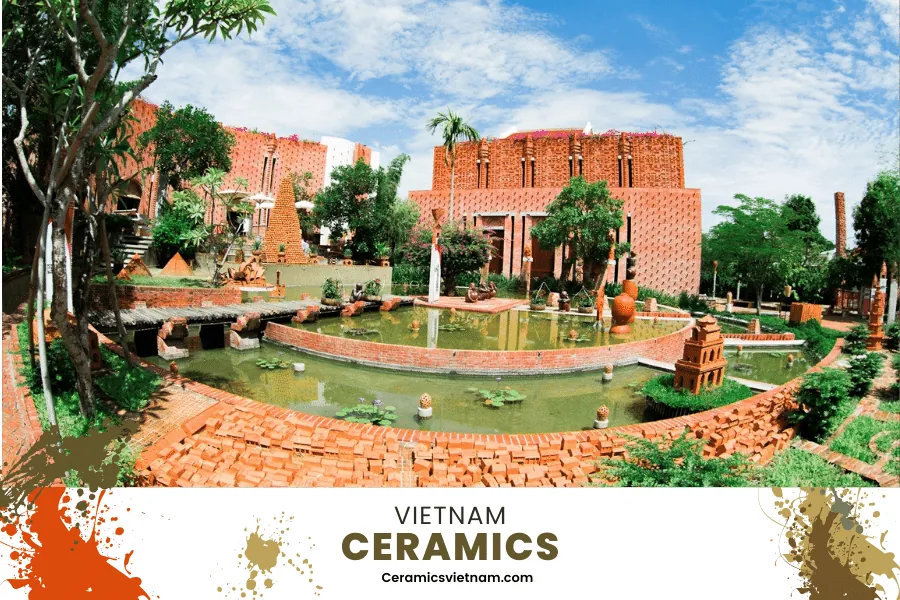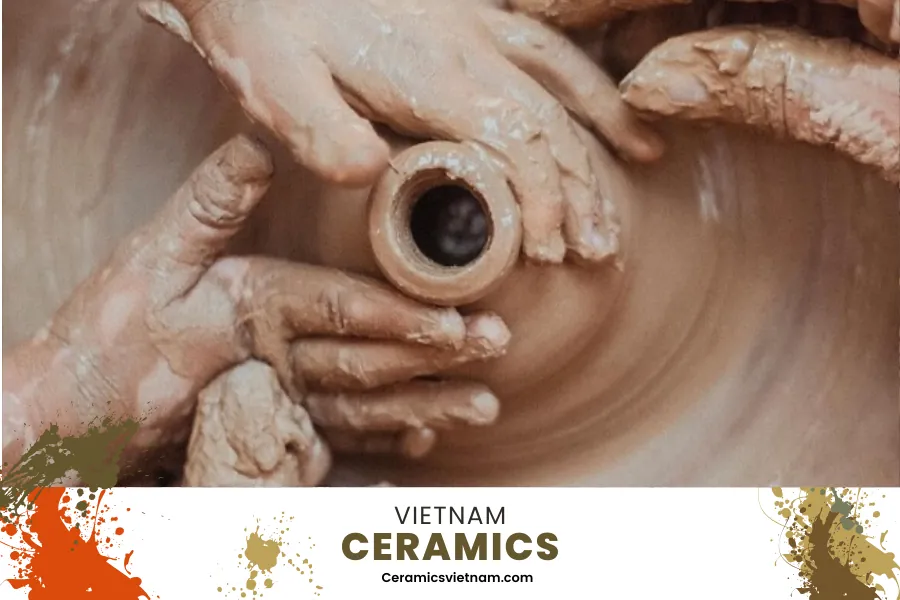Nestled in the charming town of Hoi An, Thanh Ha Pottery Village stands as a testament to Vietnam’s rich cultural heritage. With a history dating back to the 16th century, this traditional pottery village initially flourished in Thanh Chiem before finding its current home in Thanh Ha. The village’s proximity to the Thu Bon River adds to its serene ambiance, making it a picturesque destination that reflects the beauty of Vietnam’s ancient craft traditions. Pottery Village of Thanh Ha, Hoi An – Explore the Largest Pottery Park in Vietnam
Hội An is a charming town located in the Chợ Mới district of An Giang province, Vietnam. It is renowned for its well-preserved ancient architecture, vibrant culture, and rich history. One notable attraction within Hội An is the Thanh Hà Pottery Village.
The town covers an area of 22.98 square kilometers, and as of 2022, the population is 18,225 people, resulting in a population density of 793 people per square kilometer.
Thanh Hà Pottery Village: One of the highlights of Hội An is the Thanh Hà Pottery Village, a traditional craft village with a history dating back centuries. This village is famous for its skilled artisans who create unique and exquisite pottery products. Visitors to Thanh Hà can witness the intricate process of pottery making, from shaping the clay to firing the final products in traditional kilns. The village is not only a testament to the local craftsmanship but also offers an immersive experience into the cultural heritage of the region.
Introduction to Thanh Ha Pottery Park, the largest pottery park in Vietnam

Pottery Village of Thanh Ha, Hoi An – Explore the Largest Pottery Park in Vietnam
At the heart of Thanh Ha Pottery Village lies the magnificent Thanh Ha Pottery Park, celebrated as the largest of its kind in Vietnam. Established just five years ago, this park serves as a living museum, preserving and showcasing the unique artistry of Thanh Ha’s centuries-old pottery craft. With an investment exceeding 22 billion VND, the park covers an expansive area of nearly 6,000 square meters.
Unlike any other, Thanh Ha Pottery Park is an architectural marvel, designed and built by the visionary architect Nguyen Van Nguyen. It consists of two main buildings, each symbolizing a crucial aspect of the village’s pottery-making history. The left building represents the “updraft kiln,” offering insights into the historical process of shaping Thanh Ha’s pottery and displaying ancient artifacts. On the right, the “dragon kiln” is a homage to renowned artisans, exhibiting their masterpieces alongside works from other traditional craft villages like Bat Trang, Phu Lang, and Vinh Long.
With its fascinating exhibits, Thanh Ha Pottery Park has become a haven for those seeking to explore the intricate world of Vietnamese pottery. From the historical artifacts on display to the hands-on experience provided to visitors, this park promises an immersive journey into the heart of Thanh Ha’s cultural legacy.
Getting there

Pottery Village of Thanh Ha, Hoi An – Explore the Largest Pottery Park in Vietnam
Location of Thanh Ha Pottery Village
Situated in close proximity to Hoi An Ancient Town, Thanh Ha Pottery Village boasts a strategic location in the Quang Nam province of Vietnam. Specifically located at Pham Phan, Block 5, Thanh Ha Ward, the village is easily accessible and serves as a cultural gem within the region.
Directions from Hoi An Ancient Town to Thanh Ha Pottery Village
For those wandering the ancient streets of Hoi An, a visit to Thanh Ha Pottery Village is a short and rewarding journey. To reach this traditional pottery haven, one can follow the route from Hoi An Ancient Town. Heading towards Vinh Dien from the bustling Hoi An Market, visitors will encounter the Fish Market. From there, they can proceed along Duy Tan Street, and at the Chau Nhung Bridge, a signpost will guide them towards the entrance of Thanh Ha Pottery Village.
Nestled approximately 3 kilometers west of Hoi An Ancient Town, the journey to Thanh Ha Pottery Village is both convenient and culturally enriching. The signs directing towards the village ensure that the captivating world of traditional Vietnamese pottery is just a short venture away from the vibrant streets of Hoi An.
Proximity to the Thu Bon River
Adding to the allure of Thanh Ha Pottery Village is its idyllic location along the banks of the Thu Bon River. The gentle flow of the river complements the serene ambiance of the village, creating a tranquil backdrop for the centuries-old craft that has thrived in this region. Visitors can enjoy a scenic walk along the riverbanks, absorbing the peaceful atmosphere and marveling at the historical significance of the Thu Bon River in shaping the destiny of Thanh Ha Pottery Village.
Exploring the traditional pottery craft
Historical Background of Thanh Ha Pottery Village
- Origin in the 16th Century in Thanh Chiem: Thanh Ha Pottery Village traces its roots back to the 16th century when it was initially established in Thanh Chiem. Over the years, the village evolved and flourished, becoming synonymous with exceptional pottery craftsmanship. The 16th-century origins reflect the deep historical roots embedded in the culture and heritage of Thanh Ha Pottery.
- Relocation to Thanh Ha and Its Significance: Subsequently, the village underwent a crucial relocation to Thanh Ha, which is now part of Hoi An Ancient Town. This move played a pivotal role in shaping the destiny of Thanh Ha Pottery Village, aligning it with the rich history and cultural heritage of the Hoi An region. The relocation added a new chapter to the village’s story, marking its enduring significance in Vietnamese pottery traditions.
Traditional Pottery-Making Process in Thanh Ha

Pottery Village of Thanh Ha, Hoi An – Explore the Largest Pottery Park in Vietnam
- Clay Preparation and Characteristics: The heart of Thanh Ha’s pottery craft lies in the meticulous preparation of clay. The distinctive clay used in Thanh Ha Pottery is characterized by its fine, pliable texture and high adhesive properties. The colors predominantly range from earthy browns to vibrant yellows and deep reds, imparting a unique identity to Thanh Ha pottery.
- Handcrafting on Unique Pottery Wheels: The traditional pottery-making process in Thanh Ha involves skilled artisans using unique pottery wheels. These wheels, operated by hand, showcase the dexterity and artistic flair of the craftsmen. The shaping and molding of the clay take place on these specialized wheels, allowing the artisans to create intricate designs and forms that define Thanh Ha’s distinctive pottery style.
- Sun Drying and Firing in Kilns: Following the handcrafting process, the pottery pieces are carefully sun-dried, harnessing the natural elements to enhance their durability. Subsequently, the dried creations undergo firing in kilns, a critical step that requires precision in temperature and timing. The kiln-firing process not only solidifies the pottery but also imparts the final touches, resulting in the unique and resilient Thanh Ha pottery products. This meticulous approach has been passed down through generations, contributing to the village’s reputation as a custodian of traditional Vietnamese pottery craftsmanship.
The Thanh Ha Pottery Park

Pottery Village of Thanh Ha, Hoi An – Explore the Largest Pottery Park in Vietnam
Overview of the Park: The Thanh Ha Pottery Park stands as a testament to the rich cultural heritage and artistic prowess of Thanh Ha Pottery Village. Established five years ago, this expansive park spans nearly 6,000 square meters and represents a significant investment of over 22 billion VND. Conceived and constructed by architect Nguyen Van Nguyen, the park serves as a captivating blend of history, tradition, and contemporary creativity.
Entrance Fees and Operating Hours: To experience the wonders within the Thanh Ha Pottery Park, visitors can enter by paying a nominal fee:
- Adults: 40,000 VND per ticket
- Children: 29,000 VND per ticket Operating hours are from 08:30 to 17:30 daily, ensuring ample time for exploration and appreciation.
Attractions Within the Park:
- Display of Historical Artifacts: The park’s left-wing building symbolizes the “updraft kiln” and houses a collection of historical artifacts, preserving the essence of Thanh Ha’s pottery evolution over centuries.
- Traditional Pottery Products Exhibition: The right-wing building, representing the “fire kiln,” is dedicated to showcasing exquisite pottery products crafted by renowned artisans. This exhibition provides insights into the intricate artistry and diverse designs of Thanh Ha pottery.
- Miniature Replicas Showcasing Vietnamese Architecture and Global Wonders: The park features a unique section where meticulously crafted miniature replicas showcase iconic Vietnamese architectural marvels alongside renowned global wonders. From the Sydney Opera House to the Taj Mahal, visitors can marvel at these intricately designed replicas.
- Various Specialized Areas Within the Park:
- Pottery Kiln Zone: Visitors can explore different types of pottery kilns, gaining a firsthand understanding of the firing process crucial to Thanh Ha’s pottery craftsmanship.
- Traditional Craft Museum: The museum within the park offers a comprehensive look at the historical journey of Thanh Ha Pottery Village, preserving the cultural nuances and traditional techniques.
- Product Market for Souvenir Shopping: A dedicated area allows visitors to purchase souvenirs, providing a tangible connection to the artistry and craftsmanship of Thanh Ha pottery.
- Clay Market Featuring Diverse Clay Colors: A vibrant clay market showcases an array of clay colors, highlighting the raw materials integral to Thanh Ha’s distinctive pottery.
- Small-Scale Replicas of World Wonders: The park’s miniature replicas zone brings to life iconic world wonders, offering visitors a unique perspective on global heritage.
- Decorative Gardens: Scattered throughout the park are beautifully landscaped decorative gardens, creating serene spaces for contemplation and appreciation.
- Production Workshop Areas: Live workshops demonstrate the intricate pottery-making process, allowing visitors to witness the skill and dedication of Thanh Ha’s artisans.
- Exhibit of Sa Huynh – Champa Pottery: A dedicated area highlights the unique characteristics of Sa Huynh – Champa pottery, contributing to the broader narrative of Vietnam’s ceramic heritage.
- Display of Traditional Craft Villages: Visitors can explore displays dedicated to various traditional craft villages, fostering an understanding of Vietnam’s diverse artistic traditions.
- Exhibition of Priceless Ancient Artifacts: The park is home to a curated exhibition featuring priceless ancient artifacts, providing a glimpse into the historical significance of Thanh Ha Pottery.
The Thanh Ha Pottery Park stands as a multifaceted destination, seamlessly blending education, art appreciation, and cultural immersion. Visitors are invited to embark on a journey through time, witnessing the evolution of Thanh Ha’s pottery legacy amidst the serene surroundings of this expansive park.
Experiencing Thanh Ha Pottery Village

Pottery Village of Thanh Ha, Hoi An – Explore the Largest Pottery Park in Vietnam
Hands-on Experience for Visitors: Thanh Ha Pottery Village goes beyond being a mere attraction; it offers an immersive experience for visitors eager to delve into the world of pottery craftsmanship.
- Participating in the Pottery-making Process: Visitors are not just spectators; they are invited to roll up their sleeves and actively engage in the pottery-making process. From preparing the clay to shaping it on the pottery wheel, participants experience the artistry firsthand.
- Crafting Personalized Pottery Items to Take Home: The highlight of the visit is the opportunity for visitors to craft their personalized pottery items. Guided by skilled artisans, guests can create unique pieces that reflect their creativity and carry a tangible memory of their time in Thanh Ha Pottery Village.
Interaction with Skilled Artisans: Thanh Ha Pottery Village takes pride in its community of skilled artisans, and visitors have the chance to interact with these master craftsmen, gaining insights into their techniques and understanding the passion that fuels their creations.
Importance of Preserving Thanh Ha’s Traditional Pottery Craftsmanship: The hands-on experience and interaction with artisans underscore the significance of preserving Thanh Ha’s traditional pottery craftsmanship. Visitors gain a profound appreciation for the meticulous processes, cultural heritage, and the dedication required to sustain this time-honored craft.
The experience goes beyond observation; it is a journey of active participation, fostering a deeper connection between visitors and the rich cultural legacy of Thanh Ha Pottery Village. Through hands-on engagement and meaningful interactions, guests contribute to the preservation of this traditional art form, ensuring its continuity for generations to come.
Significance of Thanh Ha Pottery Village and Park in Preserving Cultural Heritage: Thanh Ha Pottery Village and its expansive Pottery Park stand as more than tourist destinations; they are bastions of cultural heritage and historical significance. The preservation of Thanh Ha’s traditional pottery craftsmanship is paramount in safeguarding a legacy that spans centuries. The village’s resilience through time, marked by its origins in the 16th century and subsequent relocation, underscores its importance as a cultural treasure trove. The Pottery Park serves as a testament to the commitment of preserving and showcasing the profound artistry embedded in each pottery piece.
Invitation for Visitors to Explore the Rich History and Artistry of Thanh Ha’s Pottery Craft: In concluding our exploration of Thanh Ha Pottery Village and Park, we extend a heartfelt invitation to visitors seeking an authentic cultural experience. Venture beyond the ordinary and immerse yourself in the rich history and artistry of Thanh Ha’s pottery craft. The village, with its centuries-old traditions, welcomes you to not only witness but actively participate in the creation of pottery masterpieces. The Pottery Park, as the largest of its kind in Vietnam, offers a comprehensive journey through time, showcasing the evolution of this intricate craft.
As you explore the exhibits, engage with skilled artisans, and craft your pottery pieces, remember that you play a crucial role in preserving this cultural gem. Thanh Ha Pottery Village and Park are not just attractions; they are living embodiments of Vietnam’s cultural tapestry. So, come, be a part of history, and contribute to the continued flourishing of Thanh Ha’s timeless pottery craft.














Leave a reply